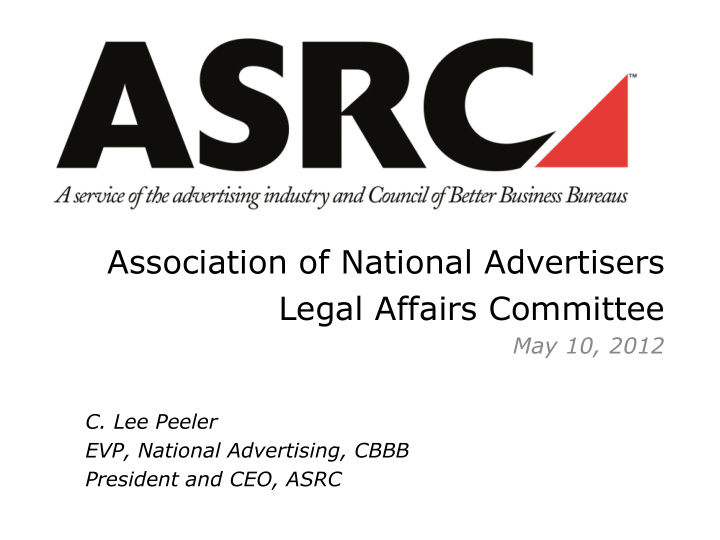



Association of National Advertisers Legal Affairs Committee May 10, 2012 C. Lee Peeler EVP, National Advertising, CBBB President and CEO, ASRC
NARC is now
Self-Regulatory Units • NAD – 1971: Developed in response to consumers’ concerns about truth and accuracy in advertising. • CARU – 1974: Chartered to assure that advertisers would take special care in addressing advertising messages to a vulnerable audience. • ERSP – 2004: Developed at the request of ERA to promote truthful and substantiated direct-response marketing claims and monitor industry “outliers.” • Children’s Food and Beverage Advertising Initiative – 2006: Formed to address broad public concern over advertising and childhood obesity. • NAD/CRN – 2007: Created in cooperation with the Council for Responsible Nutrition to expand NAD’s review of dietary -supplement advertising and rein in outrageous claims. • Online Interest-Based Advertising Accountability Program – 2011 : Developed in cooperation with the Digital Advertising Alliance to ensure industry compliance with the Self-Regulatory Principles for Online Behavioral Advertising (Principles).
National Advertising Division • Monitors national advertising in all media, enforcing high standards of claims substantiation. • Examines advertising claims made for goods and services as diverse and critical as telecommunications, infant nutrition, over-the-counter medications and dietary supplements and “green” products. • Accepts complaints from consumers, competing advertisers, local Better Business Bureaus. • NAD’s decisions represent the single largest body of decisions related to truth and accuracy in the U.S.
Children’s Advertising Review Unit • Holds advertisers to high standards of truth, appropriateness when advertising to young children. • Examines advertising in all media, including electronic media. • Monitors websites to assure that they are compliant with CARU’s guidelines.
Electronic Retailing Self-Regulation Program • Launched in cooperation with Electronic Retailing Association • Examines truth and accuracy of core claims made in electronic direct-response advertising. • Monitors $170 billion direct-response marketplace and provides strong self- regulatory presence on the frontier of electronic commerce.
Online Interest-Based Advertising Accountability Program Created by ASRC/CBBB at request of Digital Advertising Alliance (DAA) to provide an • independent, third-party enforcement mechanism for OBA Principles developed in 2009 Enforces 2009 OBA Principles, focusing primarily on compliance with two key pillars: • Transparency, which requires that companies ensure that consumers have clear and – meaningful notice of data collection and use for OBA purposes Consumer Control, which requires companies to provide consumers with easy-to- – use mechanism to exercise choice regarding the collection and use of data Monitors compliance through an accountability technology platform, research, and • complaints, institutes inquiries into cases of potential non-compliance Works with companies to expeditiously resolve instances of non-compliance. • Decisions are public, cases of non-participation or uncorrected non-compliance are • referred to FTC.
Children’s Food and Beverage Advertising Initiative • Responds to concerns regarding food advertising to young children. • Publishes regular reports on compliance, findings publicly available. • Comprised of 19 leading food and beverage companies. • Promoted the advertising of healthier products in children’s media.
Self-Regulation at Work “The industry’s uniform standards are a significant advance and exactly the type of initiative the commission had in mind when we started pushing for self-regulation more than five years ago.” FTC Chair Jon Leibowitz New York Times
Good for the Industry “Today we are proud to report that a powerful group of leaders has come together to respond to our call…the online advertising industry has been working to develop an icon that consumers could click to opt out of receiving targeted ads. Today, although it is still a work in progress, the ad industry has obtained buy-in from companies that deliver 90 percent of online behavioral advertisements; and, with the Better Business Bureau, it has established a mechanism with teeth to address non- compliance, backed up with FTC enforcement.” FTC Chair Jon Leibowitz New York Times
Good for consumers “I find it surprisingly reassuring that someone out there is making sure this stuff is on the level.” Seth Stevenson, Slate Magazine “Ad Report Card,” July 13, 2009
www.asrcreviews.org
Recommend
More recommend